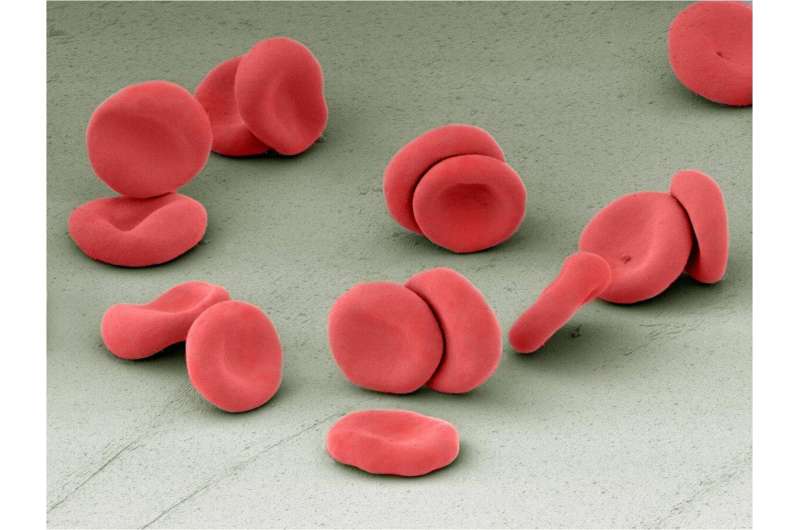This article has been reviewed according to Science X's editorial process and policies. Editors have highlighted the following attributes while ensuring the content's credibility:
fact-checked
peer-reviewed publication
trusted source
proofread
Small molecule drug reverses ADAR1-induced cancer stem cell cloning capacity

Researchers at University of California San Diego School of Medicine, Sanford Stem Cell Institute and Moores Cancer Center report that a late-stage, pre-clinical small molecule inhibitor, called rebecsinib, reverses malignant hyper-editing by an inflammation-induced protein isoform, known as ADAR1 p150. This malignant protein isoform of ADAR1 promotes immune silencing, metastasis and therapeutic resistance in 20 different cancer types.
The findings are published in Cell Stem Cell.
The ADAR1 protein is involved in making changes to RNA, a chemical cousin of DNA. Specifically, it alters the RNA-building block adenosine into a different a building block called inosine. The process is known as A-to-I editing.
Normally, ADAR1 is involved in the control of innate immune response—the body's early response to foreign invaders. A-to-I editing performed by ADAR1 changes certain aspects of the body's RNA so that it won't be attacked by the immune system. ADAR1 is also thought to inhibit replication and spread of certain viruses, such as human immunodeficiency virus and hepatitis C, by modifying their RNA. Unbridled ADAR1 overexpression, however, allows cancer cells to evade host innate immune responses.
Previous research by Jamieson and colleagues has shown that disruptive inflammatory signaling in malignant microenvironments causes ADAR1p150 overexpression, inducing chronic myeloid leukemia (CML) and malignant reprogramming of certain hematopoietic (blood) stem and progenitor cells that drive progression of pre-leukemic disorders, such as myelofibrosis, to become acute myeloid leukemia (AML). Additionally, ADAR1p150 has also emerged as both a driver of therapeutic resistance and an immune silencer in 20 different malignancies.
Both AML and CML are relatively uncommon cancers, but both can be deadly, particularly secondary AML (sAML), which has a 5-year survival rate of just 26%. More than half of patients succumb to sAML in the first year after diagnosis (10,590 deaths out of 21,380 new cases in 2017), according to the latest available data.
"Despite advances in molecularly targeted therapy, the mortality rate has remained roughly the same for more than four decades," said senior study author Catriona Jamieson, MD, Ph.D., director of the UC San Diego Sanford Stem Cell Institute, deputy director at UC San Diego Moores Cancer Center and professor of Medicine at UC San Diego School of Medicine.
"Inflammatory cytokine-induced A-to-I hyper-editing by ADAR1 has been linked to therapeutic resistance in AML, CML, multiple myeloma, myelofibrosis and 14 different solid tumor types."
In the latest study, Jamieson and co-authors sought to determine the specific drivers of malignant ADAR1 splicing and whether it could be reversed. They developed a non-invasive imaging tool using glowing firefly luciferase and green fluorescent protein technologies and assay tools, then observed that rebecsinib inhibited malignant ADAR1 splicing in a humanized mouse model of sAML.
"The goal is to stop cancer before it takes off," said Jamieson. "In these studies, rebecsinib appears to have great potential for stopping and reversing ADAR1 hyper-editing that leads from non-invasive pre-cancer to invasive cancer able to resist therapy, evade immunity and metastasize."
The authors noted that rebecsinib has been shown to be well tolerated and effective in completed pre-investigational new drug application (pre-IND) animal studies and is currently undergoing IND enabling studies.
"This study lays the foundation for clinical development of rebecsinib as a promising way to remove therapeutic resistance and relapse in patients with high-risk sAML and myelofibrosis," said Jamieson.
More information: Leslie A. Crews et al, Reversal of malignant ADAR1 splice isoform switching with Rebecsinib, Cell Stem Cell (2023). DOI: 10.1016/j.stem.2023.01.008
















